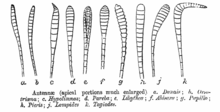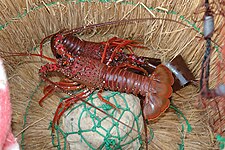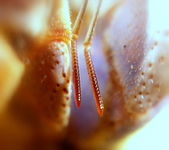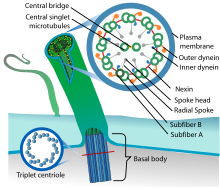This is an old revision of this page, as edited by Nczempin (talk | contribs) at 06:48, 11 April 2011 (→Insects). The present address (URL) is a permanent link to this revision, which may differ significantly from the current revision.
Revision as of 06:48, 11 April 2011 by Nczempin (talk | contribs) (→Insects)(diff) ← Previous revision | Latest revision (diff) | Newer revision → (diff)
Antennae (singular: antenna) in biology have historically been paired appendages used for sensing in arthropods. More recently, the term has also been applied to cilium structures present in most cell types of eukaryotes.
In arthropods, antennae are connected to the front-most segments. In crustaceans, they are biramous and present on the first two segments of the head, with the smaller pair known as antennules. All other arthropod groups, except chelicerates, proturans and arachnids which have none, have a single, uniramous pair of antennae. These antennae are jointed, at least at the base, and generally extend forward from the head. They are sensory organs, although the exact nature of what they sense and how they sense it is not the same in all groups, nor always clear. Functions may variously include sensing touch, air motion, heat, vibration (sound), and especially olfaction (smell) or gustation (taste).
Insects


Antennae are the primary olfactory sensors of insects and are accordingly well-equipped with a wide variety of sensilla (singular: sensillum). Paired, mobile, and segmented, they are located between the eyes on the forehead. Embryologically, they represent the appendages of the second head segment.
All insects have antenna though these may be greatly reduced in the larval forms. Amongst the non-insect classes of Hexapoda, Collembola and Diplura have antenna, but Protura do not.
Structure
The three basic segments of the typical insect antenna are the scape (base), the pedicel (stem), and finally the flagellum, which often comprises many units known as flagellomeres.
The number of flagellomeres can vary greatly, and is often of diagnostic importance. True flagellomeres have a membranous articulation between them, but in many insects, especially the more primitive groups, the flagellum is entirely or partially composed of a flexible series of small annuli, which are not true flagellomeres.
In many beetles and in the chalcidoid wasps, the apical flagellomeres form a club, and the collective term for the segments between the club and the antennal base is the funicle; for traditional reasons, in beetles it is the segments between the club and the scape, but in wasps, it is the segments between the club and the pedicel.
In the groups with more uniform antennae (for example: Diplopoda), all segments are called antennomeres. Some groups have a simple or variously modified apical or subapical bristle called an arista (this may be especially well-developed in various Diptera).
Functions
Olfactory receptors on the antennae bind to odour molecules, including pheromones. The neurons that possess these receptors signal this binding by sending action potentials down their axons to the antennal lobe in the brain. From there, neurons in the antennal lobes connect to mushroom bodies that identify the odour. The sum of the electrical potentials of the antenna to a given odour can be measured using an electroantennogram.
In the case of the Monarch butterfly, it has been shown that antennae are necessary for proper time-compensated solar compass orientation during migration, that antennal clocks exist in monarchs, and that they are likely to provide the primary timing mechanism for Sun compass orientation.
Crustaceans
Crustaceans bear two pairs of antennae. The first pair are uniramous and are often referred to as antennules, while the second pair are biramous, meaning that each antenna is composed of two parts, joined at their base . In most adults, the antenna are sensory organs, but they are used by the nauplius larva for swimming. In some groups of crustaceans, such as the spiny lobsters and slipper lobsters, the second antennae are enlarged, while in others, such as crabs, the antennae are reduced in size.
 A spiny lobster, showing the enlarged second antennae
A spiny lobster, showing the enlarged second antennae The large flattened plates in front of the eyes of a slipper lobster are the modified second antennae.
The large flattened plates in front of the eyes of a slipper lobster are the modified second antennae. The crab Cancer pagurus, showing its reduced antennae
The crab Cancer pagurus, showing its reduced antennae Antennules of the Caribbean hermit crab
Antennules of the Caribbean hermit crab
Cellular antennae

Within the biological and medical disciplines, recent discoveries have noted that primary cilia in many types of cells within eukaryotes serve as cellular antennae. These cilia play important roles in chemosensation, mechanosensation, and thermosensation. The current scientific understanding of primary cilia organelles views them as "sensory cellular antennae that coordinate a large number of cellular signaling pathways, sometimes coupling the signaling to ciliary motility or alternatively to cell division and differentiation."
"Almost every vertebrate cell has a specialized cell surface projection called a primary cilium. …primary cilia are key participants in intercellular signaling. This new appreciation of primary cilia as cellular antennae that sense a wide variety of signals could help explain why ciliary defects underlie such a wide range of human disorders, including retinal degeneration, polycystic kidney disease, Bardet-Biedl syndrome, and neural tube defects."
References
- Darby, Gene (1958). What is a butterfly?. Chicago: Benefic Press. p. 8. OCLC 1391997.
- Gullan, Penny J.; Cranston, Peter S. (2005). The Insects: an Outline of Entomology (3rd ed.). Oxford, UK: Blackwell Publishing. p. 38. ISBN 1-4051-1113-5.
- Chapman, Reginald Frederick (1998). The Insects: Structure and Function (4th ed.). New York: Cambridge University Press. p. 8. ISBN 0-521-57890-6.
- ^ Thomas A. Keil (1999). "Morphology and development of the peripheral olfactory organs". In Hansson, Bill S. (ed.). Insect Olfaction (1st ed.). Springer. pp. 5–48. ISBN 978-3540650348.
- Lawrence, Eleanor, ed. (2005). Henderson's Dictionary of Biological Terms (13th ed.). Pearson Education. p. 51. ISBN 978-0-13-127384-9.
- "Electroantennography (EAG)". Georg-August-Universität Göttingen. Retrieved March 27, 2010.
- Merlin, Christine; Gegear, Robert J.; Reppert, Steven M. (2009). "Antennal circadian clocks coordinate sun compass orientation in migratory monarch butterflies". Science. 325 (5948): 1700–1704. doi:10.1126/science.1176221. PMC 2754321. PMID 19779201.
{{cite journal}}: Unknown parameter|month=ignored (help) - "Superphylum Arthropoda". University of Arizona.
- Satir, Peter; Christensen, Søren T. (2008). "Structure and function of mammalian cilia". Histochemistry and Cell Biology. 129 (6): 687–693. doi:10.1007/s00418-008-0416-9. PMC 2386530. PMID 18365235.
{{cite journal}}: Unknown parameter|month=ignored (help) - Singla, Veena; Reiter, Jeremy F. (2006). "The primary cilium as the cell's antenna: signaling at a sensory organelle". Science. 313 (5787): 629–633. doi:10.1126/science.1124534. PMID 16888132.
{{cite journal}}: Unknown parameter|month=ignored (help)